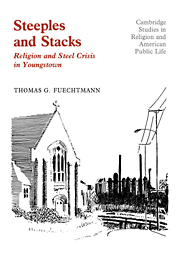Book contents
- Frontmatter
- Contents
- List of Tables and Figures
- Acknowledgments
- Introduction
- I Steeltown
- II The Industry
- III Shutdown
- IV Coping with Crisis: Community Response to the Shutdown
- V Religion and Urban Economic Crisis
- VI Launching a Movement
- VII The Plan
- VIII Negotiations
- IX Ending, Learning, Beginning Anew
- X Epilogue
- Notes
- References
- Index
IV - Coping with Crisis: Community Response to the Shutdown
Published online by Cambridge University Press: 29 March 2010
- Frontmatter
- Contents
- List of Tables and Figures
- Acknowledgments
- Introduction
- I Steeltown
- II The Industry
- III Shutdown
- IV Coping with Crisis: Community Response to the Shutdown
- V Religion and Urban Economic Crisis
- VI Launching a Movement
- VII The Plan
- VIII Negotiations
- IX Ending, Learning, Beginning Anew
- X Epilogue
- Notes
- References
- Index
Summary
On Tuesday, the day after Jennings Lambeth announced that the Campbell Works would be shutting down, many people got up and went to work the same as they had the day before. But for hundreds of workers, that normal pattern of life would be broken by the end of the week. For thousands, their lives as steelworkers would be ending within two or three months.
As steelworkers and community leaders tried to figure out the severity of the plant closing for themselves and their community, a pattern of response began to take shape. Once again, the study of natural disasters is helpful for understanding the community response to the Campbell Works shutdown.
Disaster Response
There are two key questions in assessing the response of a local community to a crisis event. First, to what extent are the community's traditional institutions capable of managing the crisis? And second, to what extent is external assistance needed to cope with the crisis, and what access does the community have to that assistance? According to Wenger (1978: 26), “Research on natural disasters has found that similar types of events, producing similar levels of physical disruption, can produce a disaster or crisis condition in one social context and have no such effect in a different social setting.” In other words, the quality of response is what defines a “disaster.” The critical factor is the crisismanagement capability of the community. The disaster event typically creates new needs in a community. If those needs can be met adequately through normal institutional channels, the crisis event does not constitute a disaster, but rather a community emergency.
- Type
- Chapter
- Information
- Steeples and StacksReligion and Steel Crisis in Youngstown, Ohio, pp. 70 - 101Publisher: Cambridge University PressPrint publication year: 1989

